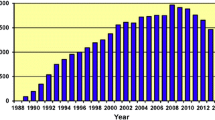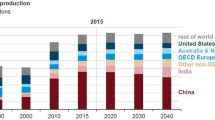Abstract
This paper summarizes five 2007–2008 resource commodity committee reports prepared by the Energy Minerals Division (EMD) of the American Association of Petroleum Geologists. Current United States and global research and development activities related to gas hydrates, gas shales, geothermal resources, oil sands, and uranium resources are included in this review. These commodity reports were written to advise EMD leadership and membership of the current status of research and development of unconventional energy resources. Unconventional energy resources are defined as those resources other than conventional oil and natural gas that typically occur in sandstone and carbonate rocks. Gas hydrate resources are potentially enormous; however, production technologies are still under development. Gas shale, geothermal, oil sand, and uranium resources are now increasing targets of exploration and development, and are rapidly becoming important energy resources that will continue to be developed in the future.







Similar content being viewed by others
Notes
U.S. Geological Survey, 956 National Center, 12201 Sunrise Valley Drive, REston, VA 20192, USA,
To whom correspondence should be addressed; e-mail: pwarwick@usgs.gov
Geoscience Integrations, Missoula, MT 59806, USA.
Hydrate Energy International, Kenner, LA 70065, USA.
Oklahoma Geological Survey, Norman, OK 73019, USA.
West Virginia Geological and Economic Survey, Morgantown, WV 26508, USA.
Bowker Petroleum LLC, The Woodlands, TX 77393, USA.
Geological Survey of Utah, Salt Lake City, UT 84114, USA.
Western Michigan University, Kalamazoo, MI 49008, USA.
Petro-Canada, Calgary, AB T2P 3E3, Canada.
Geological Survey of Utah, Salt Lake City, UT 84114, USA.
Geological Survey of Utah, Salt Lake City, UT 84114, USA.
Geothermal consultant, Inver Grove Heights, MN 55076, USA.
Energy Resources Conservation Board, Calgary, AB T2P 3G4, Canada.
M.D. Campbell and Associates, L.P., Houston, TX 77019, USA.
References
Armbrustmacher, T. J., Modreski, P. J., Hoover, D. B., and Klein, D. P., 1995, Thorium-rare earth element vein deposits, U.S. Geological Survey Open File Report 831 (Chapter 7), p. 50–53, Accessed the Internet on August 15, 2008: http://pubs.usgs.gov/of/1995/ofr-95-0831/CHAP7.pdf, last accessed September 2008.
Alberta Energy and Utilities Board, 2007, Alberta’s Energy Reserves 2006 and Supply/Demand Outlook 2007–2016, Alberta Energy and Utilities Board, Statistical Series, ST98-2007, p. 1–1 to 9–14, 4 Appendices.
Alberta Energy Resources Conservation Board, 2008, Alberta’s Energy Reserves 2007 and Supply/Demand Outlook 2008–2017, Alberta Energy and Utilities Board, Statistical Series, ST98-2008, variously paginated: http://www.ercb.ca/docs/products/STs/st98_current.pdf, last accessed September 2008.
American Association of Petroleum Geologists, Energy Minerals Division, 2007, Unconventional energy resources and geospatial information-2006 review. Natural Resources Research, 16(3), 243–261.
Campbell, M. D., King, J. D., Wise, H. D., Handley, B., and Campbell, M. D., II, in prep., The role of nuclear power in space exploration and the associated environmental safeguards: an overview, 2009 Report of the Uranium Committee: Energy Minerals Division, American Association of Petroleum Geologists. To be released at the AAPG Convention, June 21, Denver, CO.
Campbell, M. D., King, J. D., Wise, H. M., Rackley, R. I., and Handley, B. N., 2008, The Nature and extent of uranium reserves and resources and their Environmental development in the U.S. and overseas: American Association of Petroleum Geologists 2008 Annual Convention Program, 17, 27.
Campbell, M. D., Wise, H. M., and King, J. D., 2008, Nuclear fuel exploration, in situ recovery, and environmental issues in context with the national energy needs through year 2040, in Proceedings of the Texas Commission on Environmental Quality Conference and Trade Fair, April 30, Austin, Texas, CD-ROM.
Campbell, M. D., Wise, H. M., and Rackley, R. I., 2007, Uranium in situ leach (recovery) development and associated environmental issues: Gulf Coast Assoc. Geol. Soc. Trans., v. 91, 18 p: http://www.mdcampbell.com/CampbellWiseRackleyGCAGS2007.pdf, last accessed September 2008.
Campbell, M. D., Wise, H. M., and Evensen, D., 2005, Recent uranium industry developments, exploration, mining and environmental programs in the U.S. and Overseas: Report of the Uranium Committee, Energy Minerals Division, AAPG, March 25: (http://www.mdcampbell.com/2005EMDuraniumReport.pdf, last accessed February 15, 2009.
Christopher, P. A., 2007, Technical report on the Coles Hill uranium property, Pittsylvania County, Virginia (North and South Deposits), for Virginia Uranium, Inc., Chatham, Virginia, November 6 (A 43-101 Report), 49 p: http://www.mdcampbell.com/ColesHill UraniumVirginia.pdf, last accessed February 15, 2009.
Collett, T. S., Agena, W. F., Lee, M. W., Zyrianova, M. V., Bird, K. J., Charpentier, T. C., Houseknect, D. W., Klett, T. R., Pollastro, R. M., and Schenk, C. J., 2008, Assessment of gas hydrate resources on the North Slope, Alaska, 2008: U.S. Geological Survey Fact Sheet 2008–3073, 4 p: http://pubs.usgs.gov/fs/2008/3073/, last accessed March 16, 2009.
Dickinson, K. A., and Duval, J. S., 1977, Trend areas and exploration techniques—South-Texas uranium: Geologic controls, exploration techniques, and potential, in Geology [and Environmental Considerations] of Alternate Energy Resources, Uranium, Lignite, and Geothermal Energy in the South Central States, pp. 45–66 (Fig. 4D—p. 51): The Houston Geological Society, 364 p, http://www.ela-iet.com/ie08000B.htm, accessed April 1, 2007.
Dusseault, M. B., Zambrano, A., Barrios, J. R., and Guerra, C., 2008, Estimating technically recoverable reserves in the Faja Petrolifera del Orinoco—FPO, in Proceedings World Heavy Oil Congress, Edmonton 10–12 March, 2008, paper 2008–437, 6 p.
Energy Information Administration, 2009, U.S. crude oil, natural gas, and natural gas liquids reserves, 2007 annual report: Energy Information Administration, DOE/EIA-0216(2007), 145 p.
Ewing, T. E., 2004, Volcanoes, asphalt, tectonics and groundwater, Field trip guidebook, Gulf Coast Association of Geological Societies, 54th Convention, San Antonio, TX, South Texas Geological Society, Guidebook 2004–01, 92 p.
Faraj, B., Williams, H., Addison, G., McKinstry, B., Donaleshen, R., Sloan, G., Lee, J., Anderson, T., Leal, R., Anderson, C., Lafleur, C., and Ahlstrom, J., 2002, Gas shale potential of selected Upper Cretaceous, Jurassic, Triassic and Devonian shale formations in the WCSB of western Canada: implications for shale gas production: Des Plaines, Illinois, Gas Technology Institute, GRI-02/0233, compact disc, 285 p.
Faraj, B., Williams, H., Addison, G., and McKinstry, B., 2004, Gas potential of selected shale formations in the western Canadian sedimentary basin. GasTIPS, 10(1), 21–25.
Hamblin, A. P., 2006, The “shale gas” concept in Canada: a preliminary inventory of possibilities: Geological Survey of Canada, Open File 5384, 108 p.
Hein, F. J., 2006, Heavy oil and oil (tar) sands in North American: An overview and summary of contributions: Nat. Resour. Res., v. 15, no. 2, p. 67–84.
Hein, F. J., and Marsh, R. A., 2008, Regional geologic framework, depositional models and resource estimates of the oil sands of Alberta, Canada, in Proceedings World Heavy Oil Congress, Edmonton 10–12 March, 2008, paper 2008-320, 9 p.
Hein, F. J., Marsh, R. A., and Boddy, M. J., 2007, Overview of the oil sands and carbonate bitumen of Alberta: Regional geologic framework and influence of salt-dissolution effects, in Proceedings and Abstracts, American Association of Petroleum Geologists Hedberg Conference, Heavy Oil and Bitumen in Foreland Basins—From Processes to Products, September 30–October 3, 2007, Banff and Calgary, AB, Canada, extended digital abstract, modified and posted March 24, 2008, Search and Discovery Article #10145, 3 p. with 2 figures and one table: http://www.searchanddiscovery.net/documents/2008/08017hein/index.htm, last accessed September 2008.
Hein, F. J., Leckie, D., Suter, J., and Larter, S., 2007, Heavy oil and bitumen in foreland basins—From processes to products, in Core Conference, Program with Abstracts, American Association of Petroleum Geologists Hedberg Research Conference, Calgary, Alberta, 37 p.
Hernandez, E., Bauza, L., and Cadena, A., 2008, Integrated reservoir characterization and oil in place estimation for Ayacucho area, Orinoco oil belt Venezuela, in Proceedings World Heavy Oil Congress, Edmonton 10–12 March, 2008, paper 2008–426, 14 p.
Kucewicz, W. P., 2007, Electricity prices and the fuel function: An empirical and global analysis: Econ. Public Policy Rep., v. VIII, no. 1, 64 p: http://mdcampbell.com/ElectricityPricesReport2007.pdf, last accessed September 2008.
Leventhal, P., and Dolley, S., 1994, A Japanese strategic uranium reserve: A safe and economic alternative to plutonium: Sci. Global Security, v. 5, p. 1–31: http://www.mdcampbell.com/5_1leventhal.pdf, last accessed September 2008.
Marsh, R. A., and Hein, F. J., 2008, Canada’s extra-heavy (bitumen) and heavy oil resources, reserves and development. Journal of Canadian Petroleum Technology, 47 (5), 1–5. (May).
Meyer, R. F., Attanasi, E. D., and Freeman, P. A., 2007, Heavy oil and natural bitumen resources in geological basins of the world: U.S. Geological Survey Open-File Report 2007–1084, 36 p: http://pubs.usgs.gov/of/2007/1084/OF2007-1084v1.pdf, last accessed September 2008.
Pelizza, M. S., 2007, Modern in situ uranium recovery technology assures no adverse impact on adjacent aquifer uses: Gulf Coast Assoc. Geol. Soc. Trans., 91, 1, CD-ROM.
Rackley, R. I., 1975, Environment of Wyoming Tertiary uranium deposits. American Association of Petroleum Geologists Bulletin, 56(4), 755–774.
Sorensen, K., 2006, Energy from Thorium, A WebLog devoted to the discussion of thorium as a future energy resource, and the machine to extract that energy: http://thoriumenergy.blogspot.com/2006/04/welcome-and-introduction.html, last accessed August 2008.
Surkov, Y. A., Moskalyova, L. P., Manvelyan, O. S., Basilevsky, A. T., and Kharyukova, V. P., 1980, Geochemical interpretation of the results of measuring gamma-radiation of Mars, in Proceedings of the Lunar and Planetary Science 11th Conference, p. 669–676, Accessed on the Internet August 15, 2008: http://mdcampbell.com/RussianViewofMartianRadioactivityData.pdf, last accessed September 2008.
Suter, J., Leckie, D., and Larter, S., 2007, Heavy oil and bitumen in foreland basins—From processes to products, in Program with Abstracts, American Association of Petroleum Geologists Hedberg Research Conference, Banff, Alberta, 120 p.
Tester, J. W., Anderson, B. J., Batchelor, A. S., Blackwell, D. B., DiPippo, Ronald, Drake, E. L., Garnish, J., Livesay, B., Moore, M. C., Nichols, K., Petty, S., Toksöz, M. N., and Veatch, R. W., Jr., 2006, The future of geothermal energy: Idaho National Laboratory External Report INL/EXT-06-11746, Idaho Falls, ID 396 p: http://www.inl.gov/technicalpublications/Documents/3589644.pdf, last accessed April 2009.
U.S. Atomic Energy Commission, 1969, The use of thorium in nuclear power reactors, Civil Nuclear Power (Wash-UC-80), by Brookhaven National Laboratory and others, Accessed on the Internet: August 15, 2008: http://www.energyfromthorium.com/pdf/WASH-1097.pdf, last accessed September 2008.
U.S. Department of Energy, 2007, Global nuclear energy partnership strategic plan, Office of Nuclear Energy and Office of Fuel Cycle Management, GNEP-167312, Rev. 0, January, 9 p: http://www.gnep.energy.gov/pdfs/gnepStrategicPlanJanuary2007.pdf, last accessed September 2008.
Villarroel, T., 2008, New developments in Orinoco oil belt projects reflect a positive effect on the areas reserves, in Proceedings World Heavy Oil Congress, Edmonton 10–12 March, 2008, paper 2008–412, 8 p.
Zolotov, M. Y., Krot, T. V., and Moroz, L. V., 1993, K, U, and Th behavior in Martian environmental conditions, in Proceedings of the Lunar and Planetary Science 24th Conference, p. 1585–1586: http://mdcampbell.com/RussianKUThMars.pdf, last accessed September 2008.
Acknowledgments
The authors wish to thank two anonymous reviewers. Their comments greatly improved the quality of the paper.
Author information
Authors and Affiliations
Consortia
Rights and permissions
About this article
Cite this article
American Association of Petroleum Geologists, Energy Minerals Division. Unconventional Energy Resources: 2007–2008 Review. Nat Resour Res 18, 65–83 (2009). https://doi.org/10.1007/s11053-009-9094-0
Received:
Accepted:
Published:
Issue Date:
DOI: https://doi.org/10.1007/s11053-009-9094-0




